
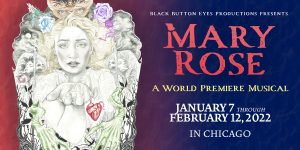 3-1/2 stars, highly recommended Black Button Eyes Production of “Mary Rose: A World Premiere Musical” is a pleasant revival of J. M. Barrie’s supernatural play, written in 1920. Barrie’s fictional account of an adult woman who never loses her youthful playfulness and charm presents a unique combination of fantasy and horror. In the 2022 musical version, director Ed Rutherford has adapted the book to suit and has added tremendous original music by Jeff Bouthiette. The collaboration between Rutherford and Bouthiette on the lyrics is fabulous, such that each of the songs is extremely descriptive of the character’s feelings and their planned actions. The underlying story is that of a young girl named Mary Rose who had been “kidnapped by a Scottish island” and how the adult Mary Rose, now wife and mother, befalls the same fate. And the best part is that she doesn’t know that she is a ghost!
3-1/2 stars, highly recommended Black Button Eyes Production of “Mary Rose: A World Premiere Musical” is a pleasant revival of J. M. Barrie’s supernatural play, written in 1920. Barrie’s fictional account of an adult woman who never loses her youthful playfulness and charm presents a unique combination of fantasy and horror. In the 2022 musical version, director Ed Rutherford has adapted the book to suit and has added tremendous original music by Jeff Bouthiette. The collaboration between Rutherford and Bouthiette on the lyrics is fabulous, such that each of the songs is extremely descriptive of the character’s feelings and their planned actions. The underlying story is that of a young girl named Mary Rose who had been “kidnapped by a Scottish island” and how the adult Mary Rose, now wife and mother, befalls the same fate. And the best part is that she doesn’t know that she is a ghost!
Rutherford masterfully combines three ways of telling the story into one and seamlessly transitions between all three. Mary Rose turns to the chaplain to tell the contemporaneous tale of her life in the first person; she turns to Simon (her fiancé, then husband) and to her parents to relive her past as a flashback; while the chorus/ensemble describes her legend in the third person (mostly at the beginning and the end of the show) to provide the background about how and why she haunts her family’s old manor house, in Sussex. Throughout the show, she plays the pivotal character who moves back and forth in time and place. We watch her enter and exit parallel worlds in her memory, her imagination, and in her physical and spiritual being. At once, she is inside the Sussex mansion and on the mystical island as she reenacts major portions of her life.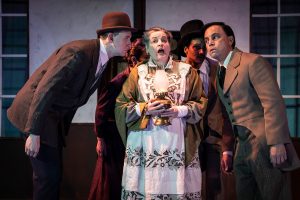
The acting and singing reign supreme in this musical. Every one of the characters has an excellent singing voice, each one better than the next. The cast is made up of Stephanie Stockstill, who plays a convincing and beguiling Mary Rose, Rosalind Hurwitz, who channels Mrs. Otery to a “T”, Quinn Corrigan (the understudy), who plays Mr. Morland, Maiko Terazawa as Mrs. Morland, Maxel Schingen as Simon, Kevin Webb as the Chaplain, and Michael Reyes as Cameron. Kudos to voice and dialect coach Carrie Hardin for getting the actors to pronounce words understandable to an American audience. The instrumentals strike just the right balance of mystery and fantasy. Thanks to music director Nick Sula and orchestrator Elinor Keener, the vocal and instrumental numbers formed a unified whole. The talented musicians (unnoticeable behind the scrim) consist of Sula (keyboard/conductor), Kimberly Lawson (violin), Rachel Schuldt (cello), and Lior Shragg (percussion). Macy Kloville’s sound design is well conceived and well done. What was really spectacular was how all sorts of reverberation and resonation were added to the actors’ voices at just the right moments to focus in on the transitions from a real world to a fantastical one. Choreography by Derek Van Barham is modest but suitably done to match an early twentieth century style of incorporating artistry on stage in the dawn of early musical theatre.
Beth Laske-Miller’s costume design is superior. All the costumes have been meticulously researched and authentically reproduced with considerable flair. While I liked all of them, I particularly loved the women’s dresses. Perhaps my favorite was the dress with the large bustle that Mary Rose wears once she marries Simon; this costume uses an array of diverse patterned fabrics to form an outfit that is beautiful and one-of-a-kind. Another costume that was appropriately lovely was the tatted frock worn by Mrs. Otery. Jeremiah Barr’s set design was nicely innovative with its smooth transition from the largest room in the mansion house to an island. I particularly liked the creative “Murphy bed” bookcase, which, when folded down from the wall, became a marshland rather than a bed. (The symbolism of this was not lost on me.) Another interesting touch is when the mansion’s fireplace becomes a portal for seeing the ocean waves. In general, the sets are not sophisticated but they are sufficient and leave a lot to the audience members’ imagination. Since the mechanisms behind the sets are handled by the actors on stage, there is no need for crew members to move things around, nor are there pauses for scene changes. This allows a nicely-timed 85-minute show (originally in three acts) to proceed with precision.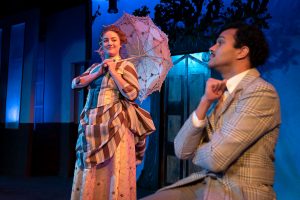
Every moment is bright and interesting, though sometimes just a little too bright. Liz Cooper’s lighting design works great for the most part. Perhaps I was seated in exactly the wrong spot in the theatre (in the third row), but when Mary Rose was called back to the island towards the end and the light shone brightly from the doors, the spotlight ahead of me was much too intense and it became painful to look at the stage. Perhaps the light could be arranged differently to prevent this problem. Another odd lighting choice was when the floodlight behind me was placed at such a low angle that my arm lit up.
In this production, the Scottish/English-based story is resurrected excellently via acting, music, and song with the technical aspects and accoutrements executed extremely well. The problem, if any, is that the ghost story of Mary Rose is relatively thin. It is unclear as to how she was abducted in the first place and whether she was beguiled as a willing participant or magically taken by force. We are told that the island was lonely, and perhaps this part is best left to the imagination. Barrie is best known for his story of “Peter Pan”, the boy who didn’t want to grow up, a theme that is similar here. The best part of “Mary Rose” is indeed the music as well as how cleverly director Rutherford rapidly shifts scenes within her life story without the audience losing track of the underlying narrative—and with nobody missing a beat.
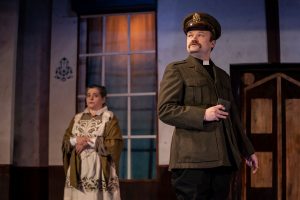 “Mary Rose” is playing through February 12, 2002, at The Edge Theater (mainstage), 5451 N. Broadway, in Chicago’s Edgewater neighborhood.
“Mary Rose” is playing through February 12, 2002, at The Edge Theater (mainstage), 5451 N. Broadway, in Chicago’s Edgewater neighborhood.
General admission tickets are $30, and are currently available at https://www.eventbrite.com/e/mary-rose-tickets-187107984017.
Performance schedule:
Thursdays, Fridays, and Saturdays at 7:30 p.m.
Sundays at 3:00 p.m.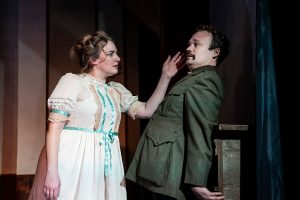
Note that in an era of COVID, all audience members must provide proof of vaccination while checking in (photo on your phone of vaccine card or actual vaccine card both accepted) and wear masks while in the venue.
All members of the cast and creative team are fully vaccinated. The Edge Theater has up to date HVAC and ventilation, and will only be selling up to 60% (out of 100) seats to allow for audience members to distance themselves comfortably. Concessions will not be sold in the lobby to minimize lowering of masks. Actors will be performing unmasked while onstage
To see what others are saying, visit www.theatreinchicago.com, go to Review Round-Up and click at “Mary Rose”.






More Stories
“The Last Five Years” MILWAUKEE
“The Trial of Themistocles” reviewed by Julia W. Rath
“Titanique”